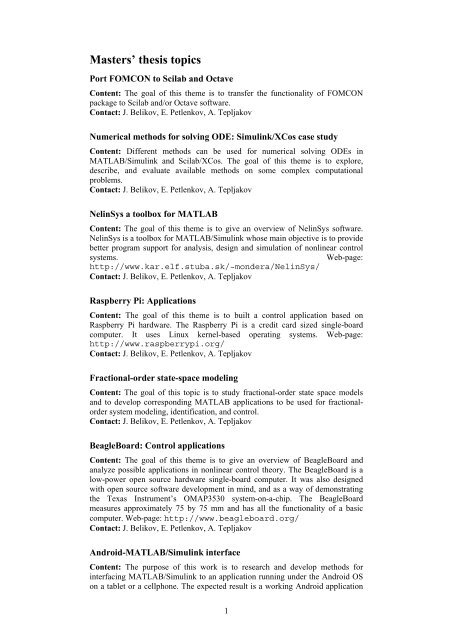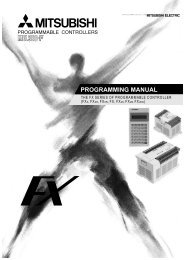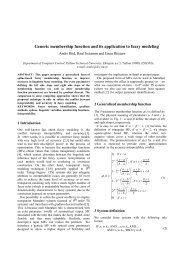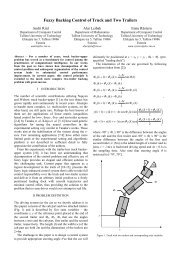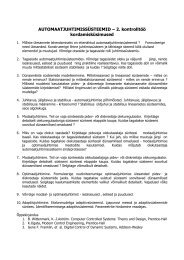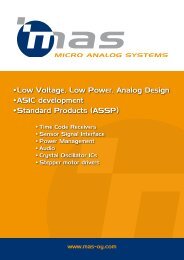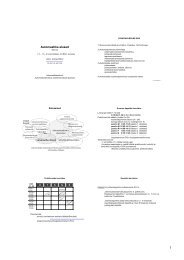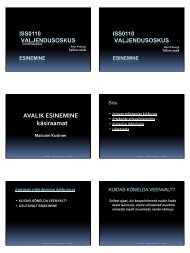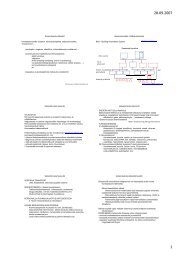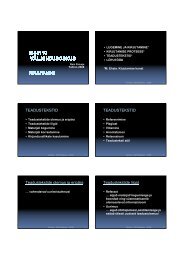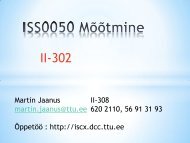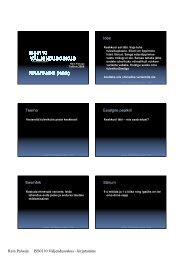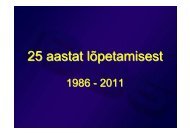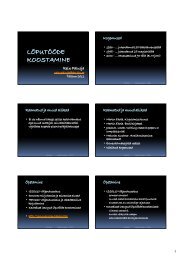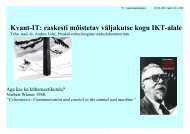Masters' thesis topics
Masters' thesis topics
Masters' thesis topics
Create successful ePaper yourself
Turn your PDF publications into a flip-book with our unique Google optimized e-Paper software.
Masters’ <strong>thesis</strong> <strong>topics</strong><br />
Port FOMCON to Scilab and Octave<br />
Content: The goal of this theme is to transfer the functionality of FOMCON<br />
package to Scilab and/or Octave software.<br />
Contact: J. Belikov, E. Petlenkov, A. Tepljakov<br />
Numerical methods for solving ODE: Simulink/XCos case study<br />
Content: Different methods can be used for numerical solving ODEs in<br />
MATLAB/Simulink and Scilab/XCos. The goal of this theme is to explore,<br />
describe, and evaluate available methods on some complex computational<br />
problems.<br />
Contact: J. Belikov, E. Petlenkov, A. Tepljakov<br />
NelinSys a toolbox for MATLAB<br />
Content: The goal of this theme is to give an overview of NelinSys software.<br />
NelinSys is a toolbox for MATLAB/Simulink whose main objective is to provide<br />
better program support for analysis, design and simulation of nonlinear control<br />
systems.<br />
Web-page:<br />
http://www.kar.elf.stuba.sk/~mondera/NelinSys/<br />
Contact: J. Belikov, E. Petlenkov, A. Tepljakov<br />
Raspberry Pi: Applications<br />
Content: The goal of this theme is to built a control application based on<br />
Raspberry Pi hardware. The Raspberry Pi is a credit card sized single-board<br />
computer. It uses Linux kernel-based operating systems. Web-page:<br />
http://www.raspberrypi.org/<br />
Contact: J. Belikov, E. Petlenkov, A. Tepljakov<br />
Fractional-order state-space modeling<br />
Content: The goal of this topic is to study fractional-order state space models<br />
and to develop corresponding MATLAB applications to be used for fractionalorder<br />
system modeling, identification, and control.<br />
Contact: J. Belikov, E. Petlenkov, A. Tepljakov<br />
BeagleBoard: Control applications<br />
Content: The goal of this theme is to give an overview of BeagleBoard and<br />
analyze possible applications in nonlinear control theory. The BeagleBoard is a<br />
low-power open source hardware single-board computer. It was also designed<br />
with open source software development in mind, and as a way of demonstrating<br />
the Texas Instrument’s OMAP3530 system-on-a-chip. The BeagleBoard<br />
measures approximately 75 by 75 mm and has all the functionality of a basic<br />
computer. Web-page: http://www.beagleboard.org/<br />
Contact: J. Belikov, E. Petlenkov, A. Tepljakov<br />
Android-MATLAB/Simulink interface<br />
Content: The purpose of this work is to research and develop methods for<br />
interfacing MATLAB/Simulink to an application running under the Android OS<br />
on a tablet or a cellphone. The expected result is a working Android application<br />
1
capable of collecting data from MATLAB as well as sending data back for e.g.<br />
control purposes. The communication can be established via a Wi-Fi network or<br />
Bluetooth.<br />
Contact: J. Belikov, E. Petlenkov, A. Tepljakov<br />
Image recognition by spiking neural networks<br />
Content: Implementation of spiking neural networks and learning algorithms in<br />
Matlab. Application of Spiking Neural Networks to image and/or pattern<br />
recognition and classification.<br />
Contact: E. Petlenkov<br />
Evolutionary training of Artificial neural networks<br />
Content: Training of the ANNs is usually formulated as minimization of an error<br />
function by iteratively adjusting connection weights. Most training algorithms are<br />
based on gradient descent method. Another technique is to formulate the training<br />
process as the evolution of the weights and ANN architecture. One of the<br />
possible solutions - genetic algorithm with real-number representation.<br />
Contact: E. Petlenkov, K.Vassiljeva<br />
ISC AC generaatori- ostsilloskoobi tarkvara loomine Linux ja/või<br />
Mac arvutile<br />
(seade on HomeLabKit kohvris) . Hetkel on olemas vaid Windowsi<br />
versioon. Võimalik 2 erinevat tööd.<br />
Contact: M.Jaanus<br />
Mikroprotsessori LPC2148 baasil oleva õppemaketile eestikeelse<br />
kasutusjuhendi loomine.<br />
http://embeddedartists.com/products/education/edu_2148.php<br />
Contact: M.Jaanus<br />
Muudetava sisuga õppemaketi disain<br />
Makett läheb kasutusse kodulaborikohvris. (töö eeldab häid teadmisi<br />
elektroonikavaldkonnast)<br />
Contact: M.Jaanus<br />
Acoustical signal de-noising using multiple microphones<br />
Content: Audio signal acquisition using multiple microphones allows for<br />
concentrating on a specific sound source position and attenuating the<br />
sounds from other sources and ambient noise. The goal is to try several<br />
positioning schemes of microphones, acquire signals from multiple<br />
sources (all at author’s choice) and test several signal de-noising<br />
algorithms in MATLAB. Own suggestions on algorithms and their<br />
optimization are highly welcome.<br />
Contact: S.Astapov<br />
Source separation techniques in single and multi-sensor systems<br />
Content: Having a signal that contains signatures of several signal sources<br />
(e.g. several people talking simultaneously, cardiogram of pregnant<br />
2
woman, etc.), the task of source separation is in focusing on the signal of a<br />
specific source and extracting it from the mixture signal. The goal of the<br />
topic is to study and test source separation algorithms on different kinds of<br />
signals (acoustic, vibration, ECG, etc.). Own suggestions on algorithms<br />
and their optimization are highly welcome.<br />
Contact: S.Astapov<br />
Fitness metrics in multidimensional cluster analysis<br />
Content: A cluster is a group of objects, such that the objects in the same<br />
cluster are more similar to each other than to those in other clusters. If<br />
each object is represented by a vector of N parameters (size, duration,<br />
energy, etc.), than these objects form clusters in an N-dimensional space.<br />
Using clustering algorithms it always possible to divide all the objects into<br />
a predefined number of clusters, however to reach a desired quality of<br />
clustering, thorough analysis of data is most often needed. If the<br />
dimensionality of the object space is larger than 3, it is no longer possible<br />
to analyze heuristically. The goal is to study and/or propose own metrics<br />
of cluster fitness and test the possibilities of cluster rearrangement in order<br />
to increase clustering quality.<br />
Contact: S.Astapov<br />
Fingerprints recognition using multirate neural networks<br />
Распознавание отпечатков пальцев с помощью многоскоростных<br />
нейронных сетей<br />
Content: The goal of this theme is not only to search for the best possible<br />
multirate image processing of fingerprint images captured from fingertips<br />
with difficult conditions (e.g., dry fingertips, rough fingertips, and<br />
allergic-skin fingertips), but also to enhance the obtained results with the<br />
case of single-rate image processing of fingerprints. The<br />
MATLAB/Simulink environment can be used.<br />
Contact: I. Astrov<br />
Flight control of a ducted fan VTOL UAV for enhanced situational<br />
awareness<br />
Управление полетом для Беспилотного Летательного Аппарата<br />
(БЛА) вертикального взлета и посадки с вентилятором в<br />
кольцевом обтекателе для улучшенной ситуационной<br />
осведомленности<br />
Content: The goal of this theme is to search the critical component of the<br />
Situational Awareness (SA), the control of autonomous vertical flight of a<br />
Vertical Takeoff and Landing (VTOL) unmanned aerial vehicle (UAV)<br />
during critical situations in real-time search-and-rescue operations. The<br />
MATLAB/Simulink environment can be used.<br />
Contact: I. Astrov<br />
3
Target tracking using vision based control of motion of a multi-rotor<br />
UAV<br />
Отслеживание цели с использованием управления движением<br />
многороторного Беспилотного Летательного Аппарата (БЛА) на<br />
основе зрительного восприятия<br />
Content: The goal of this theme is to use the video camera of multi-rotor<br />
Unmanned Aerial Vehicle (UAV) to identify the location of a moving<br />
object on the ground from visual measurement. The MATLAB/Simulink<br />
environment can be used.<br />
Contact: I. Astrov<br />
4


